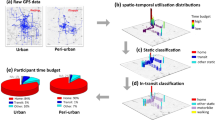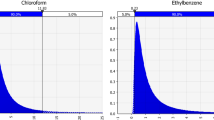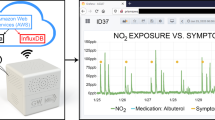Abstract
Formaldehyde is a ubiquitous environmental pollutant and is probably carcinogenic to humans. Exposure to formaldehyde was investigated in the general population with personal as well as stationary measurements. The results from two campaigns in two Swedish cities are presented, including measurements of personal exposure among a total of 65 randomly selected subjects together with simultaneous measurements of individual indoor and outdoor concentrations. Diffusive GMD samplers were placed in the breathing zone, in the participants' bedrooms, and outside their homes for 24 h in campaign A and six days in campaign B. Repeated measurements were also conducted in order to study the variability between and within individuals. Median personal exposure to formaldehyde was 22 μg/m3 (campaign A) and 23 μg/m3 (campaign B), which is within the guideline value range of 12–60 μg/m3 proposed in Sweden. Bedroom concentrations were generally slightly higher than personal exposure, while outdoor concentrations (measured only in campaign B) were low. In campaign B, the stationary measurements were used to model personal exposure. Bedroom concentrations were found to explain 90% of the variation of the measured personal exposure and predicted personal exposure nearly as well as an extended model that also included the outdoor contribution. Subjects living in single-family houses had significantly higher exposure to formaldehyde compared with subjects living in apartments. The 24-h and 6-day sampling periods yield a relatively low within-individual variability for formaldehyde measurements with GMD samplers.
This is a preview of subscription content, access via your institution
Access options
Subscribe to this journal
Receive 6 print issues and online access
$259.00 per year
only $43.17 per issue
Buy this article
- Purchase on Springer Link
- Instant access to full article PDF
Prices may be subject to local taxes which are calculated during checkout



Similar content being viewed by others
References
Bland M.J., and Altman D.G. Statistical methods for assessing agreement between two methods of clinical measurement. Lancet 1986: 8: 307–310.
Boström C.-E., Almén J., Steen B., and Westerholm R. Human exposure to urban air pollutions. Environ Health Perspect 1994: 102(Suppl): 39–47.
Brown V.M., Coward S.K.D., Crump D.R., Llewellyn J.W., Mann H.S., and Raw G.J., In: Indoor Air 2002: Proceedings of the Ninth International Conference on Indoor Air Quality and Climate, Monterey, CA, June 30–July 5, 2002. Vol. 4, pp. 473–476. Printing House, Inc., Stoughton, WI, 2002.
Clarisse B., Laurent A.M., Seta N., Le Moullec Y., El Hasnaoui A., and Momas I. Indoor aldehydes: measurements of contamination levels and identification of their determinants in Paris dwellings. Environ Res 2003: 92: 245–253.
Dingle P Personal exposure to formaldehyde. In: Indoor Air 93: Proceedings of the Sixth International Conference on Indoor Air Quality and Climate, Helsinki, Finland, July 4–8, 1993, Vol. 2, pp. 293–298, Laboratory of Heating, Ventilating and Air Conditioning, Esboo, 1993.
Fan Z., Lioy P., Weschler C., Fiedler N., Howard K., and Zhang J. Ozone-initiated reactions with mixtures of volatile organic compounds under simulated indoor conditions. Environ Sci Technol 2003: 37: 1811–1821.
Garett M.H., Hooper M.A., and Hooper B.M. Formaldehyde in Australian homes; levels and sources. Clean Air 1997: 31: 28–32.
Godish T., and Rouch J. Mitigation of residential formaldehyde contamination by indoor climate control. Am Ind Hyg Assoc J 1986: 47: 792–797.
Gonzalez-Flesca N., Cicolella A., Bates M., and Bastin E. Pilot study of personal, indoor and outdoor exposure to benzene, formaldehyde and acetaldehyde. Environ Sci Pollut Res 1999: 6: 95–102.
Hess-Kosa K. Indoor Air Quality: Sampling Methodologies. CRC Press LLC, Boca Raton, FL, 2002.
Hornung R.W., and Reed L.D. Estimation of average concentration in the presence of nondetectable values. Appl Occup Environ Hyg 1990: 5: 46–51.
IARC. Wood dust and formaldehyde. IARC Monographs on the Evaluation of Carcinogenic Risks of Chemicals to Humans, Vol. 62, IARC, Lyon, France, 1995, pp. 217–362.
Jo W.K., and Lee J.W. In-vehicle exposure to aldehydes while commuting on real commuter routes in a Korean urban area. Environ Res 2002: 88: 44–51.
Jurvelin J., Vartiainen M., Jantunen M., and Pasanen P. Personal exposure levels and microenvironmental concentrations of formaldehyde and acetaldehyde in the Helsinki metropolitan area, Finland. J Air Waste Manage Assoc 2001: 51: 17–24.
Kinney P., Chillrud S., Ramstrom S., Ross J., and Spengler J. Exposures to multiple air toxics in New York City. Environ Health Perspect 2002: 110(Suppl): 539–546.
Kromhout H., Symanski E., and Rappaport S.M. A comprehensive evaluation of within and between worker components of occupational exposure to chemical agents. Ann Occup Hyg 1993: 37: 253–270.
Lévesque B., Allaire S., Gauvin D., Koutrakis P., Gingras S., Rhainds M., Prud'Homme H., and Duchesne J.-F. Wood-burning appliances and indoor air quality. Sci Total Environ 2001: 281: 47–62.
Levin J.-O., and Lindahl R. Diffusive air sampling of reactive compounds. A review. Analyst 1994: 119: 79–83.
Levin J.-O., Lindahl R., and Andersson K. High-performance liquid-chromatographic determination of formaldehyde in air in the ppb to ppm range using diffusive sampling and hydrazone formation. Environ Technol 1988: 9: 1423–1430.
Lindahl R., Levin J.-O., and Järvholm B. Self assessment as a method for determination of exposure to formaldehyde. In: Indoor Air 99: Proceedings of the Eighth International Conference on Indoor Air Quality and Climate, Edinburgh, Scotland, August 8–13, 1999, Vol. 4, pp. 453–458. Construction Research Communications, London, 1999.
Maître A., Soulat J.-M., Stoklov M., Marquès M., and de Gaudemaris R. Exposure to carcinogenic air pollutants among policemen working close to traffic in an urban area. Scand J Work Environ Health 2002: 28: 402–410.
Norlén U., and Andersson K. Bostadsbeståndets inneklimat. ELIB-rapport nr 7, Forskningsrapport, Statens institut för byggnadsforskning TN, 30. Gävle, Sweden, 1993 (In Swedish).
Rappaport S.M., Symanski E., Yager J.W., and Kupper L.L. The relationship between environmental monitoring and biological markers in exposure assessment. Environ Health Perspect 1995: 103(Suppl 3): 49–53.
Salthammer T., Fuhrmann F., Kaufhold S., Meyer B., and Schwarz A. Effects of parameters on formaldehyde concentrations in indoor air. Indoor Air 1995: 5: 120–128.
Seinfeld J.H., and Pandis S.N. Atmospheric Chemistry and Physics: From Air Pollution to Climate Change. John Wiley & Sons, Inc., New York, 1998.
Sundell J., Andersson B., Andersson K., and Lindvall T. TVOC and formaldehyde, as risk indicators of SBS. In: Indoor Air 93: Proceedings of the Sixth International Conference on Indoor Air Quality and Climate, Helsinki, Finland. July 4–8, 1993, Vol. 1, pp. 579–584. Laboratory of Heating, Ventilating and Air Conditioning, Esboo, 1993.
US EPA. Integrated Risk Information System (IRIS) on formaldehyde. US Environmental Protection Agency, Washington, DC, 2003, Available: http://www.epa.gov/iris/subst/0419.htm(accessed 22 October 2003).
Victorin K Risk assessment of carcinogenic air pollutants. IMM-report 1/98, Institutet för miljömedicin, Stockholm, Sweden, 1998, Available: http://www.imm.ki.se/publ/PDF/Rapp1-98.pdf
WHO. Air Quality Guidelines for Europe, 2nd edn, World Health Organization Regional Office for Europe, Copenhagen, Denmark, WHO Regional Publications, European Series, No. 91, 2000, Available: http://www.who.dk/document/e71922.pdf(accessed 22 October 2003).
Acknowledgements
This study was funded by a grant from the Swedish Environmental Protection Agency. Associate Professor Elaine Symanski is gratefully acknowledged for her valuable comments on a former version of this manuscript, Carina Loh and Anders Johansson for their technical assistance, and Margaret Rhén for skilful laboratory assistance.
Author information
Authors and Affiliations
Corresponding author
Rights and permissions
About this article
Cite this article
Gustafson, P., Barregård, L., Lindahl, R. et al. Formaldehyde levels in Sweden: personal exposure, indoor, and outdoor concentrations. J Expo Sci Environ Epidemiol 15, 252–260 (2005). https://doi.org/10.1038/sj.jea.7500399
Received:
Accepted:
Published:
Issue Date:
DOI: https://doi.org/10.1038/sj.jea.7500399
Keywords
This article is cited by
-
Personal exposure to aldehydes and potential health risks among schoolchildren in the city
Environmental Science and Pollution Research (2023)
-
Facile Preparation of High Performance Low Concentration HCHO Degradation Catalyst from Waste Li-MnO2 Batteries
Journal of Inorganic and Organometallic Polymers and Materials (2023)
-
Indoor air assessment, health risks, and their relationship among elderly residents in urban warrens of Bangkok, Thailand
Air Quality, Atmosphere & Health (2015)
-
Determinants of personal exposure to some carcinogenic substances and nitrogen dioxide among the general population in five Swedish cities
Journal of Exposure Science & Environmental Epidemiology (2014)
-
Variability of environmental exposure to fine particles, black smoke, and trace elements among a Swedish population
Journal of Exposure Science & Environmental Epidemiology (2011)



